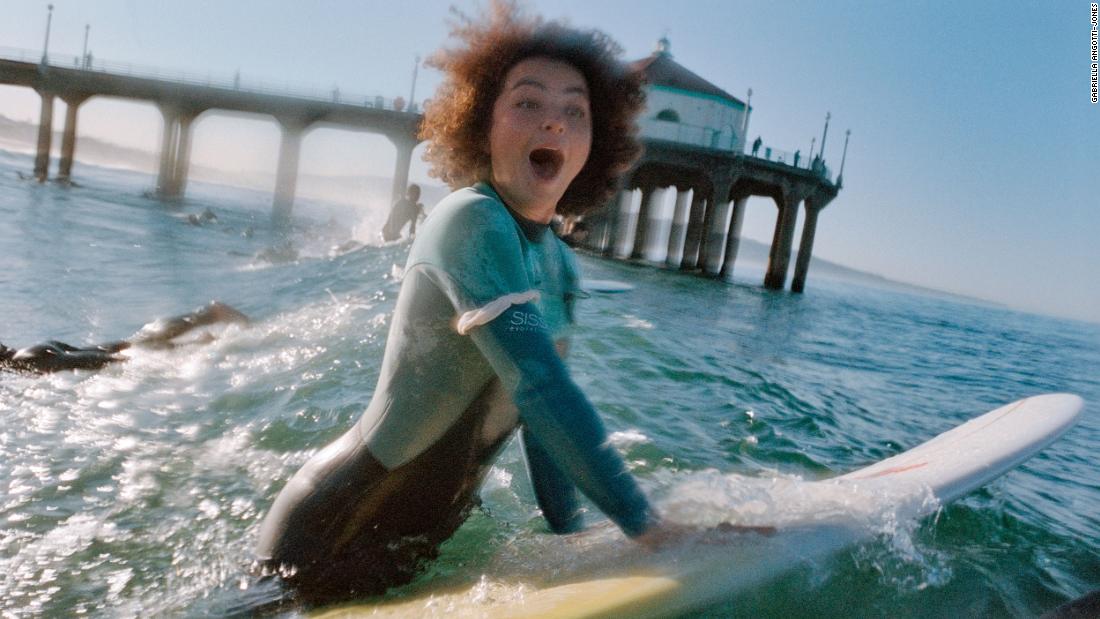Kimiko Russell-Halterman paddles out during 2021’s Black Sand Peace Paddle — an event in Manhattan Beach, California, meant to raise awareness and create space for Black surfers.
Gabriella Angotti-Jones just wanted to surf.
It was the beginning of 2019. Fresh off an internship with the New York Times, photographer Angotti-Jones was stuck freelancing — constantly worrying about when her next assignment would come.
“I felt like I was stuck in a hamster wheel,” she told CNN. “I just felt like this working machine.”
So she turned inward. With the intention of pursuing a personal project, the Capistrano Beach, California, native’s mind went to one thing: surfing.
“Like f**k — I just wanna have fun,” Angotti-Jones said. “And I just wanna surf.”


That’s the title of Angotti-Jones’ new book of photography — “I Just Wanna Surf” — available now for preorder. Centered on Black women and nonbinary surfers, its pages are filled with lush images of the sea and the people who ride its waves, with locations ranging from California to Costa Rica. But it’s also a personal heirloom, chronicling Angotti-Jones’ own journey with surfing and depression.
The project, after all, became a homecoming for Angotti-Jones. She left New York for California for a month, connecting with a group called Black Girls Surf. Armed with cheap disposable cameras, she started snapping photos of other Black women and nonbinary folks on the water. At the time, she didn’t know where it was all going. She was just having fun.

The photos in the book reflect that feeling. Surrounded by water and sand, the joy of the surfers and their community is tangible. Their grins beckon the reader closer; their body language calls on us to jump in, too.
Angotti-Jones’ work is reminiscent of surfing photography from the 1950s — fuzzy photos of people hanging out on the beach and in the water, surfboards in tow. And it’s a direct contrast to what many may picture when envisioning more commercialized surf media, showing people riding 8- to 9-foot waves and making cutbacks.
“That’s not relatable,” Angotti-Jones said. “What’s relatable is the vibes.”

Russell-Halterman and Diaz learn how to duck dive a short board in a pool in Nosara, Costa Rica.

Jackson pretends to javelin throw a piece of driftwood in Santa Barbara, California.

Clockwise from top: Jackson, Diaz, Shelby Tucker, photographer Gabriella Angotti-Jones and Marikah Burnett take a selfie on a beach in Santa Barbara.

Diaz and Jackson walk to the beach in Nosara.
But surfing and surf culture aren’t always about chill beach vibes. There can also be an intense culture of surf localism, the territorial idea that waves exist only for the locals of the area. It’s a mindset that can turn aggressive toward surfers deemed outsiders. Last year, for example, two Black surfers said they were called racist and homophobic slurs by an older White surfer while at Manhattan Beach, in an incident that quickly went viral through the local surfing community.
Angotti-Jones’ work stands in defiance to those localist ideas — highlighting instead the profound community surfing can create, particularly among Black surfers.
“I just wanted to show Black women and nonbinary people, and Black people in general, in the same context as what surfing is,” she said. “I thought that was a super powerful storytelling tool, to just be like, ‘Yeah, we’re here. We’re surfing.’”


It’s not a common sight. In the book, Angotti-Jones reveals she didn’t meet another Black surfer until January 2019.
One photo in particular stands out. Angotti-Jones captured Kimiko Russell-Halterman during 2021’s Black Sand Peace Paddle — a paddle-out at Manhattan Beach meant to raise awareness and create space for Black surfers following the incident of racial harassment.
And yet Russell-Halterman is captured in the midst of a gleeful scream, having gone out on her new longboard and popping up over a wave.


Sierra Brown applies sunscreen to her arm.

A wetsuit hangs to dry in Baja California, Mexico.
“When I look at Kimi, I just see the ocean’s joy, and I see what’s possible when you let the ocean ground you,” Angotti-Jones said.
But there are quieter moments, too. Moments spent waxing a board alone, or rubbing white-sheened sunscreen into dark skin.
In one image, a young Black girl is seen in her swimsuit in the foreground, walking ahead of a group of young White girls holding their surfboards. Though both are walking in the same direction, seemingly for the same thing, there’s a separation between the two.

All the girls were there for the same event, hosted by SurfearNegra, which aims to diversify the sport by making surfing more accessible to kids of color, and Sisters of the Sea, a group focused on introducing young women to surfing. Though the kids got along well, Angotti-Jones noticed there were still times when some of the Black surfers with less experience would separate from the White surfers, some of whom were already attending surfing competitions.
It was a feeling she recognized.
“I felt like I was reliving what I went through, which was not feeling like I was a part of it even though I was a part of it,” she said.


The book, on its surface, is about surfing. But it was also a vessel — a way for Angotti-Jones to process some of her own traumas and unearth the root causes of her depression. Her mental illness made her put up walls, she said; the Black people pictured radiate an openness she never let herself experience.
That’s what she wants her readers to remember — the Black surfer story is not defined by racism and conflict, but by love and friendship. We are not the bad things that happen to us. We are the joy and community we choose instead.

An underwater view in Guerrero, Mexico.

Shadows on a wall in Troncones, Mexico.


